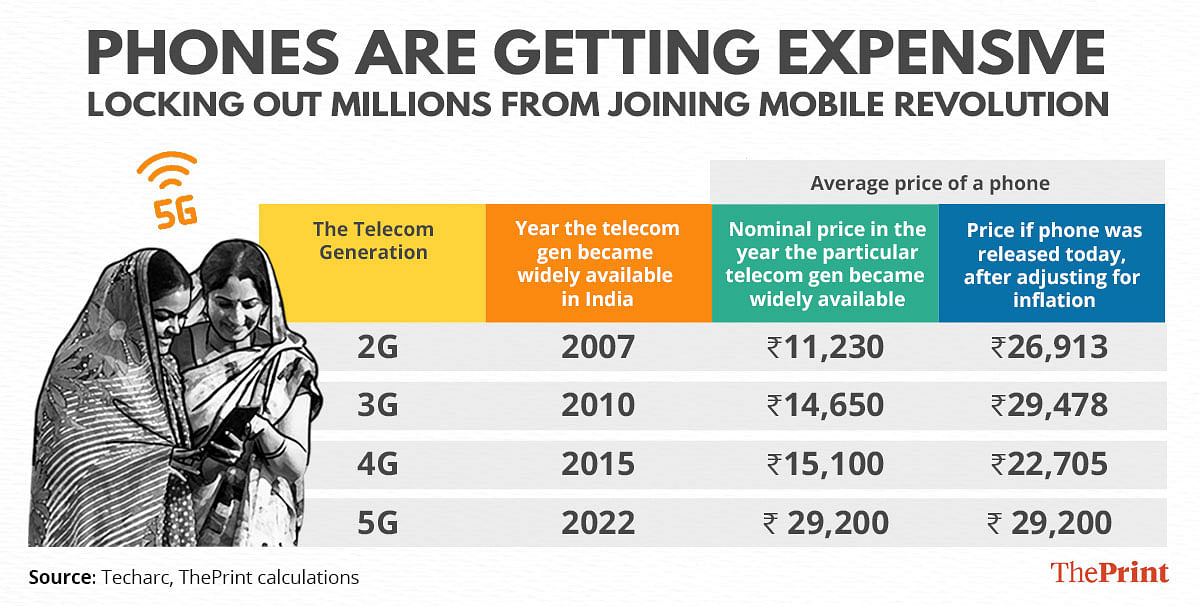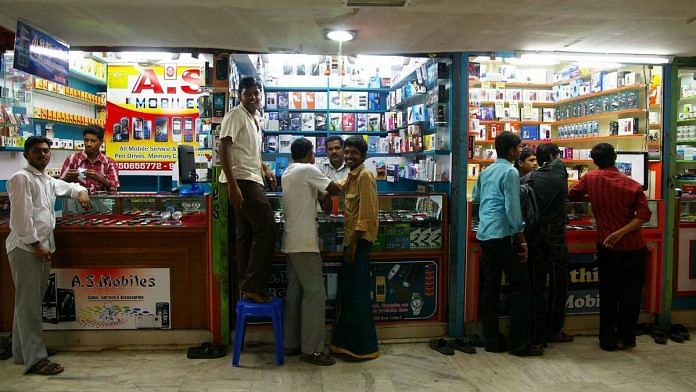New Delhi: Phones with 5G technology are more expensive than 4G phones were at the time when they became popular in India, making it difficult for people from economically weaker sections to afford these increasingly important devices, data from telecom market analytics firm Techarc and analysis by ThePrint shows.
Analysis of the data from Gurgaon-based Techarc shows that, in absolute terms, the average price of a 5G phone released in 2022 is more than double the price of a 2G phone released in 2007, when 2G technology became popular. Similarly, the price of a 5G phone is significantly higher than the prices of 3G and 4G phones released in 2010 and 2015, respectively.

However, after adjusting for inflation, the average Rs 11,230 price of a 2G phone would be almost Rs 27,000 today. The inflation-adjusted price of a 3G phone was even more unaffordable at more than Rs 29,000.
The trend seemed to change with 4G phones, which came down to an inflation-adjusted price of about Rs 22,000 per phone. Had this trend continued, 5G phones would have been within reach of a larger proportion of the population. However, the average price of a 5G phone released this year is Rs 29,200.
Faisal Kawoosa, chief analyst and founder of Techarc, said that the analysis entailed looking at the year a particular generation of telecommunication became widely available in the country, and then calculating the average price of phones on the market meant for that specific telecom generation.
“For each generation of telecom there would have been a varying number of models. The phone models looked at were across brands with various features. Phones included iOS and Android phones, starting from the 3G time,” Kawoosa said, adding that they looked at 80 to 200 models per phone generation.
While 2G was launched in India back in 1991, it became popular only around 2007. Since then, the country has quickly progressed to a level where the Prime Minister was able to launch 5G services on 1 October, 2022.
Kawoosa says making a phone expensive means losing out on a large chunk — around 55 per cent — of the potential customer base that opts for phones priced Rs 10,000-15,000. “This makes it difficult for India to mass-adopt the latest tech. We are still struggling to shed the identity of being stuck in a 2G era,” he explained.
Also Read: Rushed out to buy a new 5G phone? With consumer use still far from reality, you could have waited
Why are 5G phones pricier?
The rising prices of phones featuring the latest technology is particularly troubling in low- to middle-income countries such as India.
While some analysts attribute this to macroeconomic factors, others contend that phone- makers trapped themselves by initially offering 5G phones as premium products.
“Democratisation of 5G is yet to happen,” Prachir Singh, senior research analyst at telecom research firm Counterpoint Research said. “Currently, it is difficult to find a 5G phone around Rs 10,000, except from the from Indian brand Lava.”
Singh says the relatively slower rate of price decline to make 5G phones more affordable is partly due to macroeconomic conditions.
“Component import costs are up with the rupee weakening against the dollar and it is not economically feasible to have 5G phones priced any lower,” he explained. “In addition, it is not just the phones that need to be affordable. Tariff plans also need to be affordable and there should be applications or use cases where consumers [exclusively] need 5G.”
However, apart from macroeconomic conditions, phone makers are also to blame for the high price of 5G phones, Kawoosa said.
“While there will be extenuating macroeconomic conditions that make phones more expensive, this is not the whole case,” Kawoosa said. “Phone makers purposefully positioned 5G as a premium technology and now it’s backfiring because once it is branded as premium it is difficult to reverse the branding to make it a mass technology.”
Bharat Bhatia, president of the non-profit telecom industry body ITU-APT Foundation of India (IAFI), takes a different view and sees a 5G phone as an investment that will pay off gradually.
“Price of a phone may have increased, but how useful a phone is has also increased,” Bhatia said. “For example, let’s say two years ago, a $1,000 iPhone may have consumed about 40 GB of data in one month. But now a $1,200 iPhone can consume up to a 100 GB a month. This indicates we have found more use and use-cases or applications for a phone. So, in the long run, the price paid for a phone yields higher returns.”
Also Read: Excited for 5G? You may have to wait a bit longer for the ‘real’ thing, says telcos body chief
Costlier phones will deprive people from accessing benefits
Telecom’s role in ensuring human rights is highlighted by the UN having an action plan to give “internet access through smartphone” to “the most vulnerable”.
5G technology stands to greatly enhance India’s financial inclusion programme, apart from bringing the benefits of high-speed internet to companies and individuals alike.
Companies like Ericsson have stated that 5G technology could go a long way in bringing the digital medium to rural India but at the moment, there is a “lack of broadband Internet access” in rural areas.
“The average price of a phone increasing with each generation of telecom is really harmful,” said Kawoosa. “There are few to no reliable, high quality 5G phones under Rs 10,000 where it can be affordable to the masses.”
Smartphones have enabled not only the delivery of services to the masses by the private sector, but also the transfer of direct benefits by the government. In fact, mobiles form one of the pillars of the government’s much-publicised JAM (Jan Dhan-Aadhaar-Mobile) trinity, which facilitates direct benefit transfers of welfare subsidies into bank accounts of poor.
(Edited by Anumeha Saxena)
Also Read: What is the ‘Jan Dhan Account-Aadhaar-Mobile’ trinity & has it aided India’s war on poverty?



